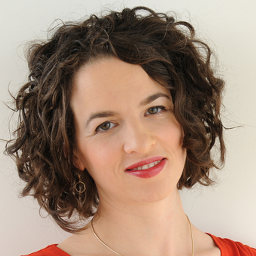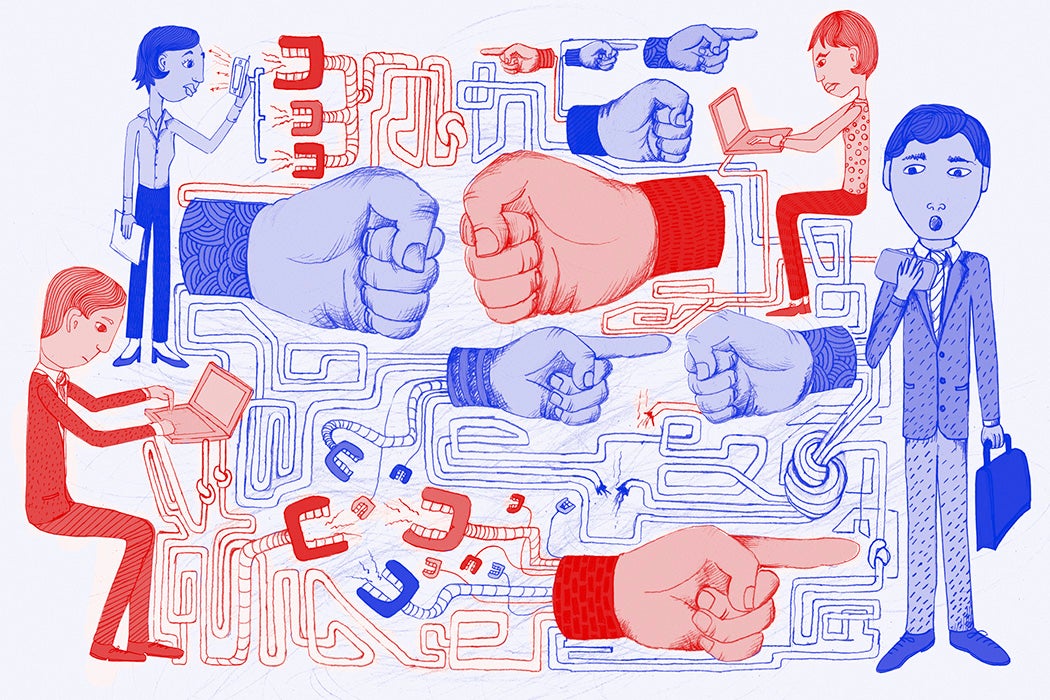If there’s one thing people seem to agree on across the American political landscape, it’s that American politics has become significantly more polarized. Before you blame Facebook, however, consider pointing the finger at Tinder and OKCupid.

On the heels of Valentine’s Day, it may seem mean-spirited to blame the sources of so much love (or at least, so much sex) for something as corrosive as polarization. But polarization is now such a fundamental and problematic part of our political climate that it’s crucial for us to take a hard look at its causes, and to consider more than just the usual suspects.
After all, marriage itself has come to reflect the extent of American polarization. As Boxell et al. point out in their 2017 article on Internet use and political polarization,
In 1960, 5% of Republicans and Democrats reported that they would “[feel] ‘displeased’ if their son or daughter married outside their political party”; by 2010, nearly 50% of Republicans and >30% of Democrats “felt somewhat or very unhappy at the prospect of interparty marriage.
But polarization is a problem for reasons that go beyond bedrooms and wedding cakes. As Iyengar et al argue in “Affect, Not Ideology”:
those who impugn the motives and character of political opponents are less likely to treat as legitimate the decisions and policies enacted when the opponents control government, and may also be less satisfied with institutions that respond to popular will. A measure of “satisfaction with democracy” shows an increasing divide between partisans since 2000. In recent years, partisans on the losing side have been substantially more dissatisfied. Dissatisfaction with policy outcomes and democratic institutions can escalate into mass protest, and in some cases to acts of violence.
If we have good reason to worry about the bitter partisanship of politics today, we’re much hazier on what’s brought us to this moment. But many people point to the Internet as a least one part of the story, arguing that a combination of personal preferences and social media algorithms have separated us into ideologically discrete news and networking “bubbles.” As Iyengar et al. put it, “[t]echnology has facilitated citizens’ ability to seek out information sources they find agreeable and tune out others that prove dissonant.” In “Digital Challenges to Democracy,” H. Akin Unver unpacks this argument:
Without equal exposure to different views, users end up thinking their view is supported by the rest of the population and develop more extreme and entrenched opinions on politics. This has led to unprecedented levels of polarization over emotionally charged policy issues, fed by bot-generated news that fit into our version of events.
And indeed, it’s hard to argue with that analysis, when it lines up with so much of our day-to-day experience online. But, that, of course is just the problem: polarization builds on our tendency to believe evidence that confirms our prior beliefs and values.
Yet it’s far from clear that online news or social media are really the drivers here. For one thing, there are plenty of arguments about polarization — and plenty of evidence — that predate the Internet. Writing in the California Law Review, for example, Richard H. Pildes makes a compelling case for the role of the Voting Rights Act in driving the past few decades of polarization:
As the VRA and related measures broke down the barriers to electoral participation in the South—literacy tests, poll taxes, manipulative registration practices, and durational residency requirements—a massive infusion of new voters, mostly black but white as well, entered and reconfigured Southern politics…Over the next generation, these new voters ripped asunder the old Democratic Party of the South, eventually fragmenting it into two parties: a highly conservative Republican Party, into which many of these formerly Democratic Southern voters fled, and a new, moderate-to-liberal Democratic Party that was more in line ideologically with the rest of the Democratic Party nationwide….Starting in the 1990s, a new feature of the recently amended VRA, the required creation of safe minority districts, added new fuel to this process.
Of course, lots of people have looked at whether and how the Internet contributes to this polarization, even if it’s simply by intensifying existing trends. But the evidence is very mixed. In “Greater Internet use is not associated with faster growth in political polarization among US demographic groups,” Boxell et al. note that “polarization has increased the most among the demographic groups least likely to use the Internet and social media”. Similarly, in “Ideological Segregation Online and Offline,” Matthew Gentzkow and Jesse M. Shapiro find that “there [is] no evidence that ideological segregation on the Internet has increased. If anything, segregation has declined as the Internet news audience has grown.” However, in “The Political Economy of New Media,” Francesco Sobbrio rattles off a list of studies that “find evidence of ideological segregation in online platforms, although with different degrees of polarization depending on the platform and the population under analysis.
While it’s tempting to take this very mixed set of conclusions as evidence that the Internet is taking way too much blame for the increasing acrimony of political life, let’s first take a closer look at the slice of online life that doesn’t get enough blame: online dating.
This scrutiny is inspired by a fascinating 2013 article in Political Behavior, “The Dating Preferences of Liberals and Conservatives.” In that article, Klofstad et al. posit that dating and mating patterns may be the real drivers of polarization. As they argue,
regardless of whether the transmission of political preferences is caused by socialization, genetics, or idiosyncratic life experiences, more often than not liberal parents produce liberal offspring, who then marry liberal partners, who then produce more liberal offspring, and so on (the same being said of conservatives). Otherwise stated, if positive assortation – like seeks like – occurs over each successive generation, it will cause a widening of the variance in the assorted trait and more individuals at the extremes in the population. In the case of assortation on political preferences, the consequence is increased political polarization.
Before you swipe left, take a moment to consider the evidence Klofstad et al marshall in support of this argument. Working from dating profiles on a single, unnamed dating site, the research team built a dataset of survey responses from nearly 3,000 men and women across the country. (They focused on straight couples because they were looking at mating outcomes — an assumption that seems to ignore all the gay couples now raising children.) Each respondent was asked to declare their own ideological viewpoint on a spectrum running from “very liberal” to very conservative”, with a couple of other options thrown in. The research team then looked at whether people sought out mates with similar ideological orientations.
They found that “both liberal and conservative daters overwhelming seek partners who are more like themselves on almost all traits, yet they do not appear to place as much weight on politics as would be expected in studies of mate assortation.” Nonetheless, they end up with people who have similar political preferences.
Klofstad et al explain this magical outcome by noting that while “ideology appears to have a direct, but small, role in mate choice”, it nonetheless influences ultimate mate choice indirectly. That’s because ideology turns out to be strongly correlated with other traits: relationship status, tobacco use, race/ethnicity, and body type. By selecting on those traits, daters end up choosing mates who are also politically similar.
Klofstad et al. use a computer model to extrapolate the impact of these mating choices on ideological polarization over many generations. The result? “[I]f all things remain constant, the number of individuals in these extreme left and right ideological tails will be almost 2 times greater in 5 generations, and 2.5 times greater in 25 generations merely as a result of assortative mating.”
Of course, if it takes five generations for mating to translate into polarization, we can hardly blame Tinder for polarization today. But as Klofstad et al point out, there’s no way of knowing where we are in this cross-generational trajectory: For all we know, this dynamic could trace back to the heightened political climate of the sixties, in which case, we’re already two or three generations into the polarization dynamic.
If so, there’s every reason to think that OKCupid, Tinder et al will accelerate rather than mitigate the role of mating in driving political polarization. After all, as Finkel at al argue in “Online Dating: A Critical Analysis From the Perspective of Psychological Science,” “Online dating is pervasive, and it has fundamentally altered both the romantic acquaintance process and the process of compatibility matching.” Precisely because online dating excels at helping people select for the traits they care about — as opposed to the serendipity of face-to-face meetings — it’s likely to reinforce the dynamics of assortative mating and ideological alignment that Klofstad et al document.
Nor will it take another two or three or four generations for those effects to be felt. In the social-media era, partnering isn’t just a merging of lives, but a merging of networks: Of my 1,499 Facebook friends, 559 are shared with my husband, a level of interdependence that seems at least as profound as the fact that we are jointly responsible for a house, a mortgage, and two children. Thanks to those 559 mutual friends, we’re part of the same online conversations, we see the same online stories, and we hear the same set of perspectives.
Weekly Newsletter
To the extent that the Internet makes it easier for us to cocoon into a like-minded bubble, our tech-enabling mating patterns land us in relationships that reinforce rather than break through that cocoon. Rather than blame social media for partisan acrimony, it’s time to admit that social media simply reflects all the many personal choices — including relationship choices — that lead us to self-segregate in ways that fuel political polarization.
Don’t worry, I’m not asking you to dump your Trump-loving husband for a Bernie bro, or even to trade your Team Warren girlfriend for a more moderate Klobuchar fan. If the large selection pool and matching efficiencies of online dating have helped you find love — even deeply partisan love — in this crazy world, that is far too great a blessing to give up on political grounds.
But we can each take care to limit the extent to which our dating and mating patterns reinforce other forms of ideological segregation in both our offline and online lives. We can resist the tendency to converge social networks with our sweethearts, and instead aim for the diversity of relationships that (as I’ve previously written) builds our resistance to the polarizing effects of fake news. We can take the comfort and security that come from walking down the wedding aisle, and turn it into the foundation for reaching across the political aisle.







